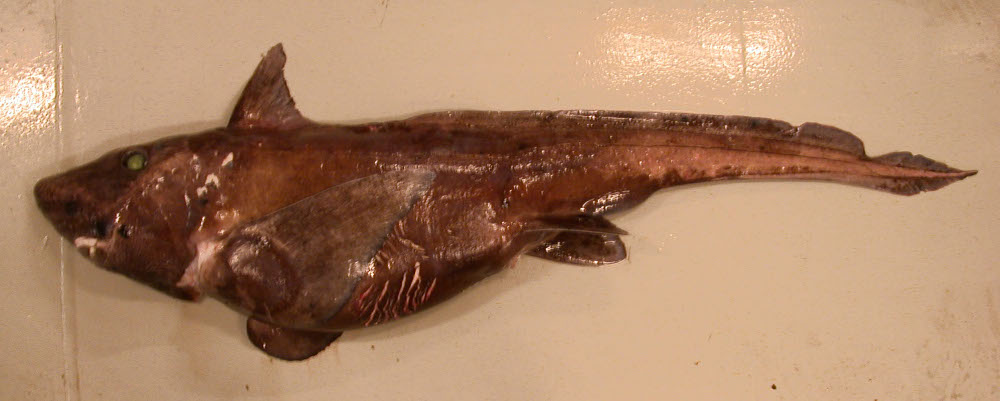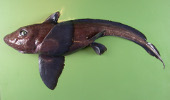Hydrolagus affinis
(De Brito Capello, 1868)
Smalleyed rabbitfish
Classification: Holocephali Chimaeriformes Chimaeridae
Reference of the original description
Descripção de dois peixes novos provenientes dos mares de Portugal. Jornal de Sciências Mathemáticas, Physicas e Naturaes, Lisboa, 1(IV), 314–322
Descripção de dois peixes novos provenientes dos mares de Portugal. Jornal de Sciências Mathemáticas, Physicas e Naturaes, Lisboa, 1(IV), 314–322
Image of the original description
.jpg)
Hydrolagus affinis (De Brito Capello, 1868)
.jpg)
Hydrolagus affinis (De Brito Capello, 1868)
Synonyms / new combinations and misspellings
Bathyalopex abbreviatus, Bathyalopex plumbeus, Chimaera abbreviata, Chimaera affinis, Chimaera plumbea, Hydrolagus cf. affinis, Psychichthys affinis
Bathyalopex abbreviatus, Bathyalopex plumbeus, Chimaera abbreviata, Chimaera affinis, Chimaera plumbea, Hydrolagus cf. affinis, Psychichthys affinis
Types
Hydrolagus affinis
Chimaera abbreviata
Holotype: USNM: 33435;
Chimaera plumbea
Holotype: USNM: 20935
Hydrolagus affinis
Chimaera abbreviata
Holotype: USNM: 33435;
Chimaera plumbea
Holotype: USNM: 20935
Description :
Citation: Hydrolagus affinis (De Brito Capello, 1868): In: Database of modern sharks, rays and chimaeras, www.shark-references.com, World Wide Web electronic publication, Version 01/2026
Please send your images of "Hydrolagus affinis" to info@shark-references.com

Hydrolagus affinis (De Brito Capello, 1868), © Alexei Orlov

Hydrolagus affinis (De Brito Capello, 1868), © Alexei Orlov
Common names
 Borrico,
Borrico,  Quimera,
Quimera,  Quimera ojo chico,
Quimera ojo chico,  Chimère de profondeur,
Chimère de profondeur,  Chimère de profondeurs,
Chimère de profondeurs,  Chimère à petits yeux,
Chimère à petits yeux,  Atlantic chimaera,
Atlantic chimaera,  Deep-water chimaera,
Deep-water chimaera,  Deepwater chimaera,
Deepwater chimaera,  Smalleyed rabbitfish,
Smalleyed rabbitfish,  Smalleyed rabbitfish fish,
Smalleyed rabbitfish fish,  Ratazana-da-fundura
Ratazana-da-fundura
 Borrico,
Borrico,  Quimera,
Quimera,  Quimera ojo chico,
Quimera ojo chico,  Chimère de profondeur,
Chimère de profondeur,  Chimère de profondeurs,
Chimère de profondeurs,  Chimère à petits yeux,
Chimère à petits yeux,  Atlantic chimaera,
Atlantic chimaera,  Deep-water chimaera,
Deep-water chimaera,  Deepwater chimaera,
Deepwater chimaera,  Smalleyed rabbitfish,
Smalleyed rabbitfish,  Smalleyed rabbitfish fish,
Smalleyed rabbitfish fish,  Ratazana-da-fundura
Ratazana-da-fundura
Short Description
Field marks and Diagnostic Features after EBERT & STEHMANN, 2013 [17836]: Field Marks: A very large Hydrolagus with the oral and preopercular lateral lines sharing a short, common branch, first dorsal–fin spine not exceeding fin height, second dorsal–fin height relatively even along entire fin length, and a short (less than body length) tail filament. Colour a uniform dark brown to black. Diagnostic Features: Body very stout, tapering from large head to relatively short whiplike filamentous tail; caudal filament ends in a blunt tip, its length ranges from 17 to 89% of body length. Snout bluntly pointed. Eyes large, 16 to 25% head length. Lateral line canals on head appear as open grooves, canals on the snout characterized by wide dilations. Preopercular and oral canals share a short common branch from the infraorbital canal; in rare cases branching together from the infraorbital canal. Skin rubbery, not deciduous, usually remains mostly intact. Pectoral fins broadly triangular, reaching to pelvic–fin base when laid back. Pelvic fins squared along distal edge and rounded ventrally. Males with robust frontal tenaculum with smooth, curved dorsal surface bulbous rounded tip, denticles do not extend on dorsal surface. Pre-pelvic tenaculum with at least five large denticles along medial edge. Pelvic claspers stout with bulbous fleshy tips covered by a shagreen of denticles; divided for the distal one-third of their length, reaching just to distal edge of pelvic fin. Males without postanal pads, females with large postanal pads. First dorsal fin high and triangular, with short fin-base; fin preceded by a stout spine, smooth along its anterior edge with two rows of serrations along the posterior edge for the distal one-third to onehalf spine length; spine tip just reaches to origin of second dorsal fin when depressed. Second dorsal fin long, continuous to upper caudal–fin lobe, and relatively even (3 to 9% body length) in height along its length. Caudal–fin dorsal and ventral lobes are rounded and nearly even in height; dorsal lobe slightly taller (3 to 4% body length) than lower lobe (2 to 4%); insertion of ventral caudal lobe posterior to insertion of dorsal caudal lobe. Colour: uniformly dark brown to purplish black, pale along ventral edge of tail and around mouth. Pectoral and pelvic fins are evenly coloured, dark brown to purplish black. In some specimens the dorsal parts of the trunk and the base of the second dorsal fin may be slightly mottled.
Field marks and Diagnostic Features after EBERT & STEHMANN, 2013 [17836]: Field Marks: A very large Hydrolagus with the oral and preopercular lateral lines sharing a short, common branch, first dorsal–fin spine not exceeding fin height, second dorsal–fin height relatively even along entire fin length, and a short (less than body length) tail filament. Colour a uniform dark brown to black. Diagnostic Features: Body very stout, tapering from large head to relatively short whiplike filamentous tail; caudal filament ends in a blunt tip, its length ranges from 17 to 89% of body length. Snout bluntly pointed. Eyes large, 16 to 25% head length. Lateral line canals on head appear as open grooves, canals on the snout characterized by wide dilations. Preopercular and oral canals share a short common branch from the infraorbital canal; in rare cases branching together from the infraorbital canal. Skin rubbery, not deciduous, usually remains mostly intact. Pectoral fins broadly triangular, reaching to pelvic–fin base when laid back. Pelvic fins squared along distal edge and rounded ventrally. Males with robust frontal tenaculum with smooth, curved dorsal surface bulbous rounded tip, denticles do not extend on dorsal surface. Pre-pelvic tenaculum with at least five large denticles along medial edge. Pelvic claspers stout with bulbous fleshy tips covered by a shagreen of denticles; divided for the distal one-third of their length, reaching just to distal edge of pelvic fin. Males without postanal pads, females with large postanal pads. First dorsal fin high and triangular, with short fin-base; fin preceded by a stout spine, smooth along its anterior edge with two rows of serrations along the posterior edge for the distal one-third to onehalf spine length; spine tip just reaches to origin of second dorsal fin when depressed. Second dorsal fin long, continuous to upper caudal–fin lobe, and relatively even (3 to 9% body length) in height along its length. Caudal–fin dorsal and ventral lobes are rounded and nearly even in height; dorsal lobe slightly taller (3 to 4% body length) than lower lobe (2 to 4%); insertion of ventral caudal lobe posterior to insertion of dorsal caudal lobe. Colour: uniformly dark brown to purplish black, pale along ventral edge of tail and around mouth. Pectoral and pelvic fins are evenly coloured, dark brown to purplish black. In some specimens the dorsal parts of the trunk and the base of the second dorsal fin may be slightly mottled.
Distribution
Northeast Atlantic: Rockall Trough along Ireland, northern Bay of Biscay and off Portugal. Reported from Iceland [20065]. Southwest Atlantic: Uruguay [5839]. Northwest Atlantic: Newfoundland in Canada to Cape Cod in USA. Probably has a much wider distribution. Possibly occurring off the Cape in South Africa and off Mozambique [20053]. Source: www.gbif.org
Northeast Atlantic: Rockall Trough along Ireland, northern Bay of Biscay and off Portugal. Reported from Iceland [20065]. Southwest Atlantic: Uruguay [5839]. Northwest Atlantic: Newfoundland in Canada to Cape Cod in USA. Probably has a much wider distribution. Possibly occurring off the Cape in South Africa and off Mozambique [20053]. Source: www.gbif.org
Human uses
fisheries: of no interest
fisheries: of no interest
Biology
Oviparous [17086]. Found on continental slopes and down to deep-sea plains. Feeds on small fishes and invertebrates [3598].
Oviparous [17086]. Found on continental slopes and down to deep-sea plains. Feeds on small fishes and invertebrates [3598].
Size / Weight / Age
Maximum TL 147 cm (96 cm body length); maximum female TL at least 125 cm, total body length 86 cm; male total length uncertain, but largest total body length 88.5 cm. Minimum size at maturity is attained at 66 cm body length (males) and at 68.5 cm body length (female). Size at birth uncertain, but the smallest free-swimming individual was 32 cm total length (14 cm body length) [17836]
Maximum TL 147 cm (96 cm body length); maximum female TL at least 125 cm, total body length 86 cm; male total length uncertain, but largest total body length 88.5 cm. Minimum size at maturity is attained at 66 cm body length (males) and at 68.5 cm body length (female). Size at birth uncertain, but the smallest free-swimming individual was 32 cm total length (14 cm body length) [17836]
Habitat
bathydemersal; marine; depth range 300 m to at least 2410 m depth, but is most common below 1000 m [17836]
bathydemersal; marine; depth range 300 m to at least 2410 m depth, but is most common below 1000 m [17836]
Remarks
shark-references Species-ID=3068;
shark-references Species-ID=3068;
Parasites (arranged by Jürgen Pollerspöck)
Monogenea
Cestoda
Trematoda
Nematoda
Copepoda
Monogenea
- Calicotyle sp. [16971]
Cestoda
- Gyrocotyle abyssicola Van Der Land & Templeman, 1968 [16971]
- Gyrocotyle major Van Der Land & Templeman, 1968 [16971]
Trematoda
- Chimaerohemecus sp. [16971] [7400] [19641]
- Gonocerca phycidis Manter, 1925 [16971]
- Multicalyx sp. [16971]
Nematoda
- Pseudanisakis tricupola Gibson, 1973 [17029]
Copepoda


















